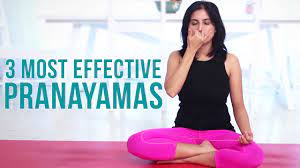Pranayama Breathing Exercises: Discover the Power of Breath
In our fast-paced and hectic lives, finding moments of calm and inner peace can be a challenge. However, there is a simple yet powerful tool that can help us tap into our inner serenity: pranayama breathing exercises. Derived from ancient yogic practices, pranayama techniques offer a pathway to harness the transformative power of breath.
Pranayama, which translates to “extension of life force,” focuses on controlling and directing the breath to enhance physical, mental, and spiritual well-being. It is believed that by regulating our breath, we can influence our energy flow and bring harmony to our mind and body.
One of the most fundamental pranayama techniques is deep belly breathing or diaphragmatic breathing. This technique involves consciously inhaling deeply through the nose, allowing the breath to expand the belly fully, and exhaling slowly through the nose. By engaging the diaphragm in this way, we activate the body’s relaxation response, leading to reduced stress levels and increased feelings of calmness.
Another popular pranayama technique is alternate nostril breathing or Nadi Shodhana. This practice involves using your thumb and ring finger to alternately close one nostril while inhaling deeply through the other nostril. The breath is then held momentarily before exhaling through the opposite nostril. This technique aims to balance the energy channels in our body and promote mental clarity.
Kapalabhati or “skull shining breath” is another dynamic pranayama exercise that involves forceful exhalations through the nose while keeping inhalations passive. This rapid exhalation technique helps cleanse the respiratory system and invigorate both body and mind.
The benefits of incorporating pranayama into your daily routine are numerous. Regular practice can improve lung capacity, enhance oxygenation throughout the body, reduce anxiety levels, and promote mental clarity. Pranayama is also known to regulate blood pressure, boost the immune system, and aid in digestion.
To begin your pranayama practice, it is essential to find a quiet and comfortable space where you can focus on your breath. Start with just a few minutes each day and gradually increase the duration as you become more comfortable. Remember to listen to your body and never force your breath. The key is to cultivate a sense of ease and relaxation.
As with any new practice, it is beneficial to learn pranayama techniques from a qualified instructor who can guide you through the correct methods and ensure proper alignment. They can also help tailor the practice to suit your individual needs and goals.
Incorporating pranayama breathing exercises into your daily routine can be a game-changer for overall well-being. By harnessing the power of breath, we tap into our innate ability to find calmness, balance, and inner peace amidst life’s challenges. So take a deep breath, let go of stress, and embark on a journey of self-discovery through the transformative practice of pranayama.
7 Essential Tips for Pranayama Breathing Exercises in English (UK)
- Start slowly
- Find a comfortable position
- Focus on your breath
- Be mindful of time
- Practice regularly
- Warm up first
- Seek guidance from an expert
Start slowly
When it comes to pranayama breathing exercises, one of the most important tips to keep in mind is to start slowly. While the benefits of pranayama are vast, it’s crucial to approach these techniques with patience and respect for your body’s limitations.
Pranayama is a practice that requires mindful awareness and gentle progression. Just as you wouldn’t rush into running a marathon without training, you shouldn’t rush into advanced breathing exercises without building a solid foundation.
Starting slowly allows your body and mind to adapt gradually. Begin with basic techniques such as deep belly breathing or diaphragmatic breathing. Take time to understand the mechanics of each breath, focusing on inhaling deeply and exhaling fully.
As you become comfortable with the basics, gradually introduce more advanced pranayama techniques under the guidance of a qualified instructor. Remember, there is no rush or competition in this practice. It’s about listening to your body and honoring its needs.
By starting slowly, you give yourself the opportunity to cultivate a strong foundation in pranayama. This foundation will not only ensure safety but also allow you to explore deeper levels of breath control and experience the full benefits of this ancient practice.
So take your time, be patient with yourself, and embrace the journey of self-discovery through pranayama. With each breath, you’ll discover new depths within yourself and unlock the transformative power of conscious breathing.
Find a comfortable position
When it comes to practicing pranayama breathing exercises, finding a comfortable position is key. The right posture allows you to fully focus on your breath and experience the benefits of these techniques.
First and foremost, choose a quiet and peaceful space where you can practice without distractions. Whether you prefer sitting on a cushion or a chair, make sure your spine is straight and aligned. This helps create an open pathway for breath to flow freely.
If sitting cross-legged on the floor feels comfortable for you, try the classic Lotus or Half-Lotus position. Rest your hands on your knees or in a mudra (a hand gesture that enhances energy flow). Alternatively, if sitting on the floor isn’t accessible for you, find a sturdy chair with your feet flat on the ground.
Ensure that your shoulders are relaxed and not hunched forward. Allow your chest to open up, giving room for deep inhalations and exhalations. You may find it helpful to gently roll your shoulders back a few times before settling into your chosen position.
As you settle into your posture, bring awareness to any tension in your body and consciously release it. Relax your facial muscles, soften your jaw, and let go of any unnecessary tension in your neck and shoulders.
Finding comfort extends beyond just physical positioning; it also involves creating an environment that supports relaxation. Dim the lights if possible or create a soothing ambiance with soft music or nature sounds. This helps create an atmosphere conducive to calmness and tranquility.
Remember, finding comfort is unique to each individual. What works for one person may not work for another. Listen to your body’s cues and make adjustments as needed until you find the position that allows you to fully engage with the practice.
By prioritizing comfort during pranayama breathing exercises, we set ourselves up for success in cultivating mindfulness and reaping the benefits of this ancient practice. So take a moment to find that perfect position, settle in, and embark on a journey of self-discovery through the power of breath.
Focus on your breath
In the midst of our busy lives, it can be easy to get caught up in the chaos and lose touch with our inner selves. However, there is a simple yet profound tip that can help bring us back to the present moment: focusing on our breath during pranayama breathing exercises.
When we consciously direct our attention to our breath, we enter a state of mindfulness and become fully aware of each inhalation and exhalation. This act of observation allows us to anchor ourselves in the present, letting go of worries about the past or future.
Focusing on our breath during pranayama exercises has numerous benefits. Firstly, it helps quieten the mind and brings a sense of calmness. As we concentrate on the rhythm and depth of our breath, other thoughts naturally fade away, creating space for stillness and inner peace.
Secondly, this mindful focus enhances our connection with our body. We become more attuned to the sensations of each breath—how it travels through our nostrils, expands our chest or belly, and then gently releases. This heightened awareness deepens our understanding of how breath affects different parts of our body and how it can be used as a tool for healing and relaxation.
Lastly, focusing on your breath during pranayama exercises cultivates a sense of presence and self-awareness. By observing your breath without judgment or attachment, you develop a deeper understanding of your own patterns of breathing—whether they are shallow or deep, steady or erratic. This self-awareness enables you to make conscious adjustments to optimize your breathing patterns for better physical and mental well-being.
To incorporate this tip into your practice, find a quiet space where you can sit comfortably without distractions. Close your eyes if it feels comfortable for you. Begin by taking a few slow deep breaths to settle into the practice. Then shift your attention solely onto your breath—observe its natural rhythm without trying to alter it. Notice the sensations of each inhale and exhale, the rise and fall of your chest or belly, and the subtle pauses in between. If your mind wanders, gently bring it back to the breath, without judgment.
By focusing on your breath during pranayama exercises, you open yourself up to a world of self-discovery and inner peace. This simple yet powerful practice can be incorporated into your daily routine, whether it’s during a dedicated meditation session or as a brief moment of mindfulness amidst a busy day. So take a deep breath, tune into the present moment, and let the transformative power of focused breathing guide you towards greater well-being.
Be mindful of time
When it comes to practicing pranayama breathing exercises, one important tip to keep in mind is to be mindful of time. While it may be tempting to rush through your practice or extend it indefinitely, finding a balance and setting a dedicated time frame can greatly enhance the effectiveness and consistency of your practice.
Being mindful of time allows you to create a structured routine that fits seamlessly into your daily life. Choose a time of day when you are least likely to be interrupted or distracted. It could be early morning, before starting your day, or in the evening as a way to wind down and relax. By setting aside a specific time for pranayama, you prioritize self-care and make it an integral part of your daily routine.
Setting a realistic duration for your practice is equally important. Start with shorter sessions, such as 5-10 minutes, and gradually increase the duration as you become more comfortable and experienced. Remember that consistency is key; even short daily practices can yield significant benefits over time.
By being mindful of time during your pranayama practice, you cultivate discipline and focus. Treat this dedicated period as sacred and create an environment free from distractions. Switch off your phone, find a quiet space, and allow yourself to fully immerse in the practice.
However, it’s also essential not to become overly rigid or stressed about adhering strictly to a fixed schedule. Life happens, and there may be days when circumstances prevent you from practicing at the usual time or for the usual duration. In such cases, adaptability is key. Be flexible enough to adjust your practice without feeling guilty or discouraged.
Remember that the goal of pranayama is not just about ticking off minutes on the clock but rather about cultivating mindfulness and connecting with your breath on a deeper level. So even if you have limited time available on certain days, make the most of it by focusing on quality rather than quantity.
Being mindful of time in your pranayama practice helps you establish a consistent routine, create a dedicated space for self-care, and cultivate discipline and focus. By setting realistic goals and maintaining flexibility, you can make pranayama an integral part of your daily life, allowing its transformative benefits to unfold gradually. So, embrace the power of time management and embark on a journey of breath awareness and inner harmony through pranayama.
Practice regularly
Practice Regularly: Unlock the Full Potential of Pranayama Breathing Exercises
When it comes to reaping the benefits of pranayama breathing exercises, consistency is key. Just as a plant needs regular watering to thrive, the practice of pranayama requires regular attention and dedication to unlock its full potential.
Practicing pranayama regularly allows you to build a strong foundation and deepen your understanding of this ancient art. Like any skill, it takes time and repetition to develop proficiency. By committing to a consistent practice, you give yourself the opportunity to explore the intricacies of each technique and experience their transformative effects.
Regular practice not only strengthens your physical ability but also cultivates mental discipline. By setting aside dedicated time each day for pranayama, you create a space for self-care and introspection. This consistent routine helps train your mind to focus, allowing you to immerse yourself fully in the present moment.
One of the beautiful aspects of pranayama is its adaptability. Whether you have just a few minutes or an hour to spare, there are techniques suitable for any timeframe. Consistency doesn’t necessarily mean long sessions; it means finding a rhythm that works for you and sticking with it.
To establish a regular practice, start small and gradually increase the duration as you become more comfortable. Begin with short sessions that feel manageable within your daily routine. It could be five minutes in the morning or a brief break during your lunch hour. As you become more accustomed to the practice, gradually extend the duration or add additional sessions throughout the day.
Creating a dedicated space for your practice can also enhance consistency. Designate an area in your home where you feel calm and at ease—a corner filled with cushions or a peaceful spot in nature can work wonders. Having this designated space serves as a visual reminder and encourages regularity by making your practice more accessible.
Remember that progress in pranayama is not measured by how far you can stretch or how long you can hold a pose. It’s about the quality of your breath, the state of your mind, and the connection you establish with yourself. Each day is an opportunity to deepen your understanding and experience the subtle shifts that come with regular practice.
So, commit to yourself and make pranayama a part of your daily routine. Embrace the transformative power of consistency and watch as this ancient practice unfolds its magic in your life. With each breath, you embark on a journey towards greater well-being, inner peace, and self-discovery.
Warm up first
When it comes to practicing pranayama breathing exercises, one important tip to keep in mind is to warm up your body first. Just as we warm up before engaging in physical exercise, warming up before pranayama helps prepare the body and mind for the practice ahead.
Warming up can be as simple as performing a few gentle stretches or engaging in a short yoga sequence. This helps loosen the muscles, increase blood flow, and awaken the body. By doing so, you create a foundation of ease and openness that allows for a more effective and comfortable pranayama practice.
A warm-up routine can also help shift your focus from external distractions to your internal state. It serves as a transition from the busyness of everyday life into a more present and mindful space. This mental preparation allows you to fully immerse yourself in the practice of pranayama, enhancing its benefits.
Incorporating gentle movements, such as neck rolls, shoulder rolls, or side stretches, can help release tension accumulated throughout the day. Additionally, incorporating some simple breathing exercises like deep belly breaths or gentle sighs can further relax and center your mind.
Remember that warming up doesn’t have to be time-consuming or elaborate. Even just a few minutes dedicated to stretching and connecting with your breath can make a significant difference in preparing yourself for pranayama.
By warming up before pranayama, you set the stage for a more mindful and fulfilling practice. It allows you to approach each breath with intention and awareness. So take a moment to tune into your body, gently awaken your muscles, and prepare yourself mentally before diving into the transformative world of pranayama breathing exercises.
Seek guidance from an expert
When it comes to exploring the world of pranayama breathing exercises, seeking guidance from an expert can make all the difference. While there are many resources available online and in books, having a knowledgeable instructor by your side can provide invaluable insights and ensure that you practice safely and effectively.
Pranayama techniques involve working with the breath, which is a subtle and powerful force. An experienced instructor can help you understand the nuances of each technique, guide you through correct posture and alignment, and tailor the practice to suit your specific needs and abilities.
By learning from an expert, you gain access to their wealth of knowledge and experience. They can answer your questions, offer personalized tips, and provide adjustments or modifications as needed. Their guidance helps you build a strong foundation in pranayama practice, allowing you to deepen your understanding and reap maximum benefits.
Moreover, pranayama is not just about physical techniques; it encompasses a holistic approach to well-being. A skilled instructor can introduce you to the philosophical aspects of pranayama, including its connection to meditation and spirituality. They can help you integrate breathwork into your overall wellness routine for a more comprehensive transformative experience.
Additionally, an expert instructor creates a supportive environment where you can feel comfortable exploring pranayama at your own pace. They understand that each individual is unique and may have different goals or challenges. With their guidance, you can progress gradually while honoring your body’s limitations and finding joy in the journey.
Whether you are new to pranayama or seeking to deepen your existing practice, investing in guidance from an expert is a wise choice. Look for qualified instructors who have undergone proper training and certification in pranayama or yoga teaching. Seek recommendations from trusted sources or consider joining classes or workshops led by reputable professionals.
Remember that pranayama is not just about mastering techniques; it is about cultivating awareness, connection, and inner harmony through the breath. With the guidance of an expert, you can embark on a transformative journey that goes beyond physical exercise, and discover the profound benefits of pranayama in your daily life.




